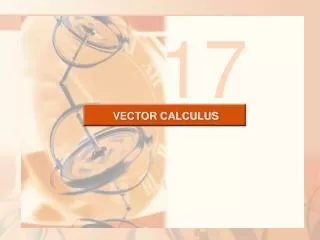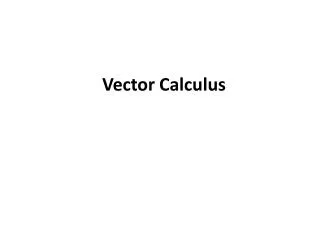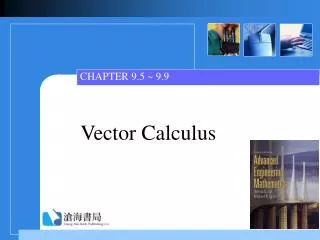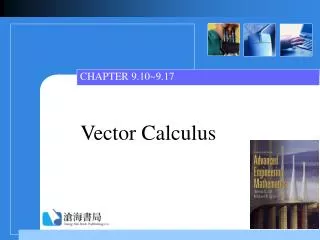VECTOR CALCULUS
16. VECTOR CALCULUS. VECTOR CALCULUS. 16.3 Fundamental Theorem for Line Integrals. In this section, we will learn about: The Fundamental Theorem for line integrals and determining conservative vector fields. FTC2. Equation 1.
Share Presentation
Embed Code
Link
Download Presentation
- theorem
- vector field
- theorem 2
- vector fields
- conservative vector fields
- determining conservative vector fields

evelia + Follow
Download Presentation
VECTOR CALCULUS
An Image/Link below is provided (as is) to download presentation Download Policy: Content on the Website is provided to you AS IS for your information and personal use and may not be sold / licensed / shared on other websites without getting consent from its author. Content is provided to you AS IS for your information and personal use only. Download presentation by click this link. While downloading, if for some reason you are not able to download a presentation, the publisher may have deleted the file from their server. During download, if you can't get a presentation, the file might be deleted by the publisher.
Presentation Transcript
- 16 VECTOR CALCULUS
- VECTOR CALCULUS 16.3 Fundamental Theorem for Line Integrals • In this section, we will learn about: • The Fundamental Theorem for line integrals • and determining conservative vector fields.
- FTC2 Equation 1 • Recall from Section 5.3 that Part 2 of the Fundamental Theorem of Calculus (FTC2) can be written as: • where F’ is continuous on [a, b].
- NET CHANGE THEOREM • We also called Equation 1 the Net Change Theorem: • The integral of a rate of change is the net change.
- FUNDAMENTAL THEOREM (FT) FOR LINE INTEGRALS • Suppose we think of the gradient vector of a function f of two or three variables as a sort of derivative of f. • Then,the following theorem can be regarded as a version of the Fundamental Theorem for line integrals.
- FT FOR LINE INTEGRALS Theorem 2 • Let C be a smooth curve given by the vector function r(t), a≤ t ≤ b. • Let f be a differentiable function of two or three variables whose gradient vector is continuous on C. • Then,
- NOTE • Theorem 2 says that we can evaluate the line integral of a conservative vector field (the gradient vector field of the potential function f) simply by knowing the value of fat the endpoints of C. • In fact, it says that the line integral of is the net change in f.
- NOTE • If f is a function of two variables and C is a plane curve with initial point A(x1, y1) and terminal point B(x2, y2), Theorem 2 becomes:
- NOTE • If f is a function of three variables and C is a space curve joining the point A(x1, y1, z1) to the point B(x2, y2, z2), we have:
- FT FOR LINE INTEGRALS • Let’s prove Theorem 2 for this case.
- FT FOR LINE INTEGRALS Proof • Using Definition 13 in Section 16.2, we have: • The last step follows from the FTC (Equation 1).
- FT FOR LINE INTEGRALS • Though we have proved Theorem 2 for smooth curves, it is also true for piecewise-smooth curves. • This can be seen by subdividing C into a finite number of smooth curves and adding the resulting integrals.
- FT FOR LINE INTEGRALS Example 1 • Find the work done by the gravitational field • in moving a particle with mass m from the point (3, 4, 12) to the point (2, 2, 0) along a piecewise-smooth curve C. • See Example 4 in Section 16.1
- FT FOR LINE INTEGRALS Example 1 • From Section 16.1, we know that F is a conservative vector field and, in fact, , where:
- FT FOR LINE INTEGRALS Example 1 • So, by Theorem 2, the work done is:
- PATHS • Suppose C1 and C2 are two piecewise-smooth curves (which are called paths) that have the same initial point A and terminal point B. • We know from Example 4 in Section 16.2 that, in general,
- CONSERVATIVE VECTOR FIELD • However, one implication of Theorem 2 is thatwhenever is continuous. • That is, the line integral of a conservativevector field depends only on the initial point and terminal point of a curve.
- INDEPENDENCE OF PATH • In general, if F is a continuous vector field with domain D, we say that the line integral is independent of pathif • for any two paths C1 and C2 in D that have the same initial and terminal points.
- INDEPENDENCE OF PATH • With this terminology, we can say that: • Line integrals of conservative vector fields are independent of path.
- CLOSED CURVE • A curve is called closedif its terminal point coincides with its initial point, that is, r(b) = r(a)
- INDEPENDENCE OF PATH • Suppose: • is independent of path in D. • C is any closed path in D
- INDEPENDENCE OF PATH • Then, we can choose any two points Aand B on C and regard C as: • Being composed of the path C1 from A to Bfollowed by the path C2 from B to A.
- INDEPENDENCE OF PATH • Then, • This is because C1 and –C2 have the same initial and terminal points.
- INDEPENDENCE OF PATH • Conversely, if it is true that whenever C is a closed path in D, then we demonstrate independence of path as follows.
- INDEPENDENCE OF PATH • Take any two paths C1 and C2 from A to Bin D and define C to be the curve consisting of C1 followed by –C2.
- INDEPENDENCE OF PATH • Then, • Hence, • So, we have proved the following theorem.
- INDEPENDENCE OF PATH Theorem 3 • is independent of path in Dif and only if: for every closed path C in D.
- INDEPENDENCE OF PATH • We know that the line integral of any conservative vector field F is independent of path. • It follows that for any closed path.
- PHYSICAL INTERPRETATION • The physical interpretation is that: • The work done by a conservative force field (such as the gravitational or electric field in Section 16.1) as it moves an object around a closed path is 0.
- INDEPENDENCE OF PATH • The following theorem says that the only vector fields that are independent of path are conservative. • It is stated and proved for plane curves. • However, there is a similar version for space curves.
- INDEPENDENCE OF PATH • We assume that D is open—which means that, for every point P in D, there is a disk with center P that lies entirely in D. • So, D doesn’t contain any of its boundary points.
- INDEPENDENCE OF PATH • In addition, we assume that D is connected. • This means that any two points in Dcan be joined by a path that lies in D.
- CONSERVATIVE VECTOR FIELD Theorem 4 • Suppose F is a vector field that is continuous on an open, connected region D. • If is independent of path in D, then F is a conservative vector field on D. • That is,there exists a function fsuch that
- CONSERVATIVE VECTOR FIELD Proof • Let A(a, b) be a fixed point in D. • We construct the desired potential function f by defining • for any point in (x, y) in D.
- CONSERVATIVE VECTOR FIELD Proof • As is independent of path, it does not matter which path C from (a, b) to (x, y) is used to evaluate f(x, y). • Since D is open, there exists a disk contained in D with center (x, y).
- CONSERVATIVE VECTOR FIELD Proof • Choose any point (x1, y) in the disk with x1 < x. • Then, let C consist of any path C1 from (a, b) to (x1, y) followed by the horizontal line segment C2 from (x1, y) to (x, y).
- CONSERVATIVE VECTOR FIELD Proof • Then, • Notice that the first of these integrals does not depend on x. • Hence,
- CONSERVATIVE VECTOR FIELD Proof • If we write F = Pi +Qj, then • On C2, y is constant; so, dy = 0.
- CONSERVATIVE VECTOR FIELD Proof • Using t as the parameter, where x1≤ t ≤ x, we have: • by Part 1 of the Fundamental Theorem of Calculus (FTC1).
- CONSERVATIVE VECTOR FIELD Proof • A similar argument, using a vertical line segment, shows that:
- CONSERVATIVE VECTOR FIELD Proof • Thus, • This says that F is conservative.
- DETERMINING CONSERVATIVE VECTOR FIELDS • The question remains: • How is it possible to determine whether or not a vector field is conservative?
- DETERMINING CONSERVATIVE VECTOR FIELDS • Suppose it is known that F = Pi + Qjis conservative—where P and Q have continuous first-order partial derivatives. • Then, there is a function f such that ,that is,
- DETERMINING CONSERVATIVE VECTOR FIELDS • Therefore, by Clairaut’s Theorem,
- CONSERVATIVE VECTOR FIELDS Theorem 5 • If F(x, y) = P(x, y) i + Q(x, y) jis a conservative vector field, where P and Q have continuous first-order partial derivatives on a domain D, then, throughout D,we have:
- CONSERVATIVE VECTOR FIELDS • The converse of Theorem 5 is true only for a special type of region.
- SIMPLE CURVE • To explain this, we first need the concept of a simple curve—a curve that doesn’t intersect itself anywhere between its endpoints. • r(a) = r(b) for a simple, closed curve. • However, r(t1) ≠ r(t2) when a < t1 < t2 < b.
- CONSERVATIVE VECTOR FIELDS • In Theorem 4, we needed an open, connected region. • For the next theorem, we need a stronger condition.
- SIMPLY-CONNECTED REGION • A simply-connected regionin the plane is a connected region D such that every simple closed curve in D encloses only points in D. • Intuitively, it contains no hole and can’t consist of two separate pieces.
- CONSERVATIVE VECTOR FIELDS • In terms of simply-connected regions, we now state a partial converse to Theorem 5 that gives a convenient method for verifying that a vector field on is conservative. • The proof will be sketched in Section 16.3 as a consequence of Green’s Theorem. Load More .

VECTOR CALCULUS
17. VECTOR CALCULUS. VECTOR CALCULUS. 17.7 Surface Integrals. In this section, we will learn about: Integration of different types of surfaces. SURFACE INTEGRALS.
1.59k views • 103 slides

VECTOR CALCULUS
17. VECTOR CALCULUS. VECTOR CALCULUS. 17.8 Stokes’ Theorem. In this section, we will learn about: The Stokes’ Theorem and using it to evaluate integrals. . STOKES’ VS. GREEN’S THEOREM. Stokes’ Theorem can be regarded as a higher-dimensional version of Green’s Theorem.
984 views • 50 slides

VECTOR CALCULUS
16. VECTOR CALCULUS. VECTOR CALCULUS. 16.2 Line Integrals. In this section, we will learn about: Various aspects of line integrals in planes, space, and vector fields. LINE INTEGRALS.
1.6k views • 107 slides

VECTOR CALCULUS
16. VECTOR CALCULUS. VECTOR CALCULUS. 16.9 The Divergence Theorem. In this section, we will learn about: The Divergence Theorem for simple solid regions, and its applications in electric fields and fluid flow. . INTRODUCTION.
909 views • 52 slides

VECTOR CALCULUS
16. VECTOR CALCULUS. VECTOR CALCULUS. 16.3 Fundamental Theorem for Line Integrals. In this section, we will learn about: The Fundamental Theorem for line integrals and determining conservative vector fields. . FTC2. Equation 1 .
1.27k views • 89 slides

VECTOR CALCULUS
16. VECTOR CALCULUS. VECTOR CALCULUS. 16.4 Green’s Theorem. In this section, we will learn about: Green’s Theorem for various regions and its application in evaluating a line integral. INTRODUCTION.
1.04k views • 63 slides

VECTOR CALCULUS
VECTOR CALCULUS. 1.10 GRADIENT OF A SCALAR 1.11 DIVERGENCE OF A VECTOR 1.12 DIVERGENCE THEOREM 1.13 CURL OF A VECTOR 1.14 STOKES’S THEOREM 1.15 LAPLACIAN OF A SCALAR. 1.10 GRADIENT OF A SCALAR . Suppose is the temperature at ,
9.4k views • 55 slides

VECTOR CALCULUS
16. VECTOR CALCULUS. VECTOR CALCULUS. The main results of this chapter are all higher-dimensional versions of the Fundamental Theorem of Calculus (FTC). To help you remember them, we collect them here (without hypotheses) so that you can see more easily their essential similarity.
336 views • 9 slides

VECTOR CALCULUS
16. VECTOR CALCULUS. VECTOR CALCULUS. So far, we have considered special types of surfaces: Cylinders Quadric surfaces Graphs of functions of two variables Level surfaces of functions of three variables. VECTOR CALCULUS.
1.52k views • 107 slides

VECTOR CALCULUS
16. VECTOR CALCULUS. VECTOR CALCULUS. In this chapter, we study the calculus of vector fields. These are functions that assign vectors to points in space. VECTOR CALCULUS. We define:
1.02k views • 67 slides

VECTOR CALCULUS
13. VECTOR CALCULUS. VECTOR CALCULUS. 13.9 The Divergence Theorem. In this section, we will learn about: The Divergence Theorem for simple solid regions, and its applications in electric fields and fluid flow. INTRODUCTION.
725 views • 52 slides

VECTOR CALCULUS
17. VECTOR CALCULUS. VECTOR CALCULUS. Here, we define two operations that: Can be performed on vector fields. Play a basic role in the applications of vector calculus to fluid flow, electricity, and magnetism. VECTOR CALCULUS. Each operation resembles differentiation.
1.02k views • 61 slides

Vector Calculus
Vector Calculus. 1. Figure 3.1 Differential elements in the right-handed Cartesian coordinate system. Figure 3.2 Differential normal surface areas in Cartesian coordinates: (a) d S = dy dz a x , (b) d S = dx dz a y , (c) d S = dx dy a z.
1.1k views • 33 slides

VECTOR CALCULUS
17. VECTOR CALCULUS. VECTOR CALCULUS. 17.9 The Divergence Theorem. In this section, we will learn about: The Divergence Theorem for simple solid regions, and its applications in electric fields and fluid flow. INTRODUCTION.
989 views • 52 slides

VECTOR CALCULUS
16. VECTOR CALCULUS. VECTOR CALCULUS. 16.7 Surface Integrals. In this section, we will learn about: Integration of different types of surfaces. SURFACE INTEGRALS.
1.61k views • 103 slides

VECTOR CALCULUS
13. VECTOR CALCULUS. VECTOR CALCULUS. 13.8 Stokes’ Theorem. In this section, we will learn about: The Stokes’ Theorem and using it to evaluate integrals. STOKES’ VS. GREEN’S THEOREM. Stokes’ Theorem can be regarded as a higher-dimensional version of Green’s Theorem.
738 views • 50 slides

Vector Calculus
Vector Calculus. Line Integral of Vector Functions. d l = dx i + dy j + dz k. For a closed loop, i.e. ABCA ,. = circulation of P around L. Line given by L( x ( s ), y ( s ), z ( s )), s = parametric variable.
978 views • 19 slides

Vector Calculus
CHAPTER 9.5 ~ 9.9. Vector Calculus. Contents. 9.5 Directional Derivatives 9.6 Tangent Planes and Normal Lines 9.7 Divergence and Curl 9.8 Lines Integrals 9.9 Independence of Path. 9.5 Directional Derivative. Introduction See Fig 9.26. The Gradient of a Function.
1.85k views • 118 slides

Vector Calculus
CHAPTER 9.10~9.17. Vector Calculus. Contents. 9.10 Double Integrals 9.11 Double Integrals in Polar Coordinates 9.12 Green’s Theorem 9.13 Surface Integrals 9.14 Stokes’ Theorem 9.15 Triple Integrals 9.16 Divergence Theorem 9.17 Change of Variables in Multiple Integrals.
1.93k views • 124 slides

Vector Calculus
Vector Calculus. Mengxia Zhu Fall 2007. Objective. Review vector arithmetic Distinguish points and vectors Relate geometric concepts to their algebraic representation Describe point, line, and planes Exploit the dot product and cross product and their applications in Graphics.
595 views • 26 slides

Vector Calculus
Vector Calculus is a very important area in the field of Electromagnetic
572 views • 26 slides























